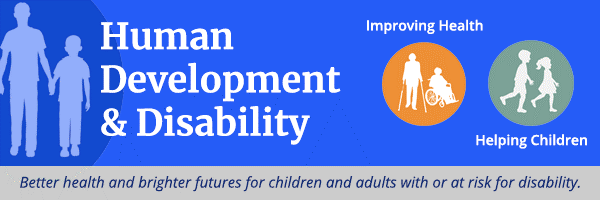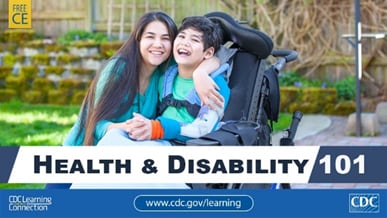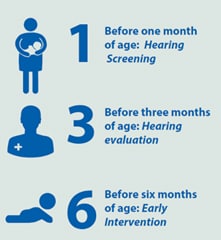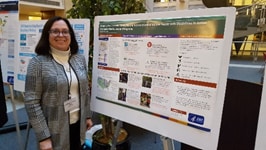DHDD Newsletter - December 2019

A Note from the DHDD Director:
Dear colleagues –
The end of the year is a time for reflection, but also for dreaming and hoping. As we reflect on the many successes and challenges of the past year, let’s consider the future and what we can accomplish together for the health and wellbeing of the populations we serve.
I wish you a wonderful holiday season and a happy new year with plenty of time to relax, recharge and enjoy time with family and friends. Thank you for all of your hard work, dedication, and collaboration in 2019 and I look forward to continuing to work with you in 2020!
Sincerely,
Dr. Georgina Peacock, Director, DHDD
In the Spotlight
December 3: International Day of Persons with Disabilities

On December 3, CDC observed the International Day of Persons with Disabilitiesexternal icon. As part of this observance, CDC developed a Feature that highlights our recent Public Health Grand Rounds – Addressing Gaps in Health Care for Individuals with Intellectual Disabilities (IDs). People with IDs are less likely to receive good health care and more likely to have poor health than people without IDs. Healthcare professionals can work with their patients with an ID, and their caregivers, to find out which care is best. Training for healthcare professionals is important to help them better care for their patients with IDs. Creating accessible healthcare systems that are inclusive and responsive to the needs of people with IDs may help improve their health and wellbeing and ensure they are active participants in their own healthcare. We look forward to continuing to collaborate with our partners to promote positive attitudes toward, and the inclusion of, people of all abilities in society and in programs that support health and prevent disease.
DHDD’s “Learn the Signs. Act Early.” program releases new children’s book: Baby’s Busy Day!

DHDD’s “Learn the Signs. Act Early.” (LTSAE) program is excited to announce the release of a new book for 1-year-olds, Baby’s Busy Day: Being One is So Much Fun!pdf icon (Un día ocupado del bebé, en Españolpdf icon). The book was launched in November at the National Association for the Education of Young Children Annual Conference in Nashville, Tennessee. Baby’s Busy Day is LTSAE’s latest children’s book meant to help parents learn more about their child’s development and encourage them to track developmental milestones.
Partners, please help us to continue to spread the word about the LTSAE children’s books and other LTSAE resources, especially CDC’s Milestone Tracker app. CDC can supply print-ready files to any organization that wishes to print and distribute the books to families. One FREE copy of the book per person is available for order.
Read more about Baby’s Busy Day and CDC’s other amazing books for children.
Health and Disability 101 Training for Health Department Employees

The Health and Disability 101 Training for Health Department Employeesexternal icon is an online training available through NACCHO’s learning management platform, NACCHO University. This training provides foundational knowledge about people with disabilities, the health disparities that they experience, and how local health department staff can include people with disabilities in their public health programs and services. Continuing education is now available for Continuing Nursing Education (CNE), Certified Health Education Specialists (CHES®), Master Certified Health Education Specialists (MCHES®), and Certified Public Health Professionals (CPH). The training is now featured on the December CDC Learning Connection website and will remain up for the entire month.
2017 Newborn Hearing Screening Data now available

About 1 in 500 babies are born deaf or hard of hearing in the U.S each year. Newborn hearing screening programs have been implemented by all 50 states and most U.S. territories to detect hearing loss in infants and minimize delays in speech, language, and social and emotional development.
To monitor progress toward national goalspdf icon, CDC collects data from state and territorial programs. Results from the 2017 CDC EHDI Hearing Screening and Follow-up Survey (HSFS) indicate that 25 percent of the newborns who failed their hearing screening did not have a documented diagnosis. In addition, nearly 20 percent of the infants diagnosed as deaf or hard of hearing could not be documented as receiving intervention services. Although most infants are identified early and receive the services they need, these data indicate that improvements are needed to make sure that all infants who are born deaf or hard of hearing reach their full potential.
Read more about the 2017 EHDI – HSFS data.
Publications
Evaluating Data Quality of Newborn Hearing Screening
Early Hearing Detection and Intervention Information Systems (EHDI-IS) assist EHDI program staff and partners in their tracking activities and provide a variety of data reports to help ensure that all children who are deaf or hard of hearing are identified early and receive recommended intervention services.
Researchers from CDC’s National Center on Birth Defects and Developmental Disabilities published a study in the Journal of Early Hearing Detection and Intervention (JEHDI)external icon looking at the quality of the data on newborn hearing screening collected by the jurisdictional-based Early Hearing Detection and Intervention Information Systems (EHDI-IS).
Between 2013 – 2016, researchers evaluated 48 EHDI-IS. Researchers found that most jurisdictional-based EHDI programs are consistently receiving newborn hearing screening results from hospitals and birthing facilities, and data reporters are willing to report according to established protocol. However, additional efforts are needed to improve the accuracy and completeness of these data, in particular, demographic data (e.g. infant name, date of birth, mother’s race, age and education), and data from infants who were transferred from other hospitals, admitted to the Neonatal Intensive Care Unit (NICU), and born outside the hospital (e.g. midwifery providers).
DHDD in the Field
Conference on Health and Active Transportation

Dr. JoAnn Thierry, Senior Scientist with DHDD’s Disability and Health Promotion Branch, presented the poster “Adapting Public Health Strategies and Interventions to Include People with Disabilities in Active Transportation Policies and Programs” at the Conference on Health and Active Transportation.
DHDD’S mission is to lead inclusive programs to optimize the health and development of children and adults with, or at risk for, disabilities.
